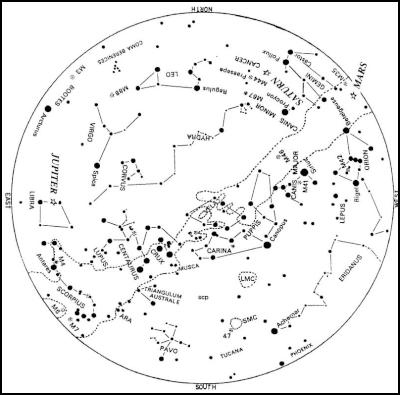The April Night Sky
The Night Sky
Brian Carter*CARTER OBSERVATORY
THE NATIONAL
OBSERVATORY OF NEW ZEALAND
THE APRIL NIGHT
SKY
We are well past the time where the nights became longer than the days. The length of the nights will continue to increase until late June.
Planets
April is an excellent month for observing the planets. All 5 major planets, Mercury, Venus, Mars, Jupiter and Saturn, are visible for the whole of the month.
Mars will be visible for the first quarter of the night. At the start of the month it sets at 21 38 and at 20 59 by month’s end. Mars starts the month in the constellation of Taurus, moving into Gemini on April 14. Its magnitude fades from 1.2 to 1.5 during the month.
Saturn will be visible for the first half of the night. At the start of March it sets at 01 03 and at 23 08 by month’s end. Saturn is in the constellation of Cancer, in which it remains until September 2006. Its magnitude slightly fades from 0.1 to 0.3.
Jupiter will be visible for all of the night. Jupiter is in the constellation of Libra, in which it remains until December 2006. During the month its magnitude slightly increases from –2.4 to –2.5, it’s brightest for the year.
Venus will be visible for the last quarter of the night. At the start of the month it rises at 02 43 and at 03 25 by month’s end. Venus starts the month in the constellation of Capricornus, moving into Aquarius on April 5, and finally into Pisces on April 29. Its brilliant magnitude fades from –4.3 to –4.1 during the month.
Mercury will be visible in the morning sky just before dawn. At the start of the month it rises at 04 24 and at 05 25 by month’s end. It starts the month in the constellation of Aquarius, moving into Pisces on April 15, moving into Cetus on April 22 and back into Pisces on April 26. Its magnitude rapidly increases from 0.7 to –0.4 during April.
All times are for Wellington unless otherwise stated. Other centres may vary by a few minutes.
Phases of the Moon
First Quarter –
April 6 at 00:01.
Full Moon – April 14 at 04:40.
Last
Quarter – April 21 at 15:28.
New Moon – April 28 at
07:44.
Diary of Astronomical Phenomena
Apr
6 Saturn stationary against the background stars at 00:00,
as its motion changes from a Westerly to an Easterly
direction.
9 Mercury at greatest Westerly elongation from
the Sun (28) at 07:00.
10 Moon at apogee
(furthest from the Earth) at 01:00 (Distance = 0.0027109 AU
= 405,540 km).
14 Full Moon at 04 40.
14 Spica 0.3°S
of the Moon at 05:00.
16 Jupiter 5°N of Moon at
03:00.
17 Antares 0.2°N of Moon at 21:00.
25 Moon at
perigee (closest to the Earth) at 23:00. (Distance =
0.0024314 AU = 363,730 km).
28 New Moon at
07:44.
MARCH SKY CHART
This chart shows the sky as it appears at about 21:00 for ~March 15.

Click for big version
How To Use the Sky Charts
To use the sky chart hold it up to the sky so that the direction in which you are looking is at the lower edge of the map. For example, if you are looking at the western horizon then the map should be held so that the “WEST” label is at the lower edge. The altitude and direction of the stars and planets will then be correctly shown. The centre of the chart will be directly overhead.
* Brian Carter is the Senior Astronomer at Carter Observatory (The National Observatory of New Zealand), PO Box 2909, Wellington. (Observatory Web Site: www.CarterObservatory.org)


 DC Harding: In The Spirit Of Natural Justice
DC Harding: In The Spirit Of Natural Justice Martin LeFevre - Meditations: Animal Encounters During Meditative States
Martin LeFevre - Meditations: Animal Encounters During Meditative States Ian Powell: Gisborne Hospital Senior Doctors Strike Highlights Important Health System Issues
Ian Powell: Gisborne Hospital Senior Doctors Strike Highlights Important Health System Issues Keith Rankin: Who, Neither Politician Nor Monarch, Executed 100,000 Civilians In A Single Night?
Keith Rankin: Who, Neither Politician Nor Monarch, Executed 100,000 Civilians In A Single Night? Eugene Doyle: Writing In The Time Of Genocide
Eugene Doyle: Writing In The Time Of Genocide Gordon Campbell: On Wealth Taxes And Capital Flight
Gordon Campbell: On Wealth Taxes And Capital Flight